Top Qs
Timeline
Chat
Perspective
Emblem of Israel
From Wikipedia, the free encyclopedia
Remove ads
The emblem of Israel (Hebrew: סמל מדינת ישראל, romanized: Sēmel Medīnat Yīsrāʾēl) depicts a temple menorah surrounded by an olive branch on each side, with the word Israel written in Hebrew (ישראל) below it. While it is commonly displayed in blue and white, the emblem has appeared in alternative colour combinations depending on the use, such as on the Israeli Presidential Standard (see below).
You can help expand this article with text translated from the corresponding article in Hebrew. Click [show] for important translation instructions.
|
Remove ads
History

The State of Israel adopted the symbol after a design competition held in 1948. The design is based on the winning entry submitted by Gabriel and Maxim Shamir's proposal, with elements taken from other submissions, including entries from Oteh Walisch, W. Struski, Itamar David, Yerachmiel Schechter, and Willie Wind, whose entry won the first design competition.[1][2] The emblem was officially adopted on February 10, 1949.[3]
Remove ads
Symbolism
Summarize
Perspective
The image used on the emblem is based on a depiction of the menorah on the Arch of Titus. The menorah was used in the ancient Temple in Jerusalem and has been a symbol of Judaism since ancient times. It symbolizes universal enlightenment, based on what is written in Isaiah 60: "Nations will come to your light, and kings to the brightness of your dawn".
According to Allon Gal,
The menorah (the seven-branched candelabrum), described in the Bible as a prominent feature of the Tabernacle erected by the People of Israel in the wilderness, as well as in the Jerusalem Temple, had for centuries served as a Jewish symbol in synagogues, and had been historically used as an emblem by a variety of Zionist organisations and associations. Eventually, it was adopted as the symbol of the State of Israel. Significantly, the design of the menorah, now flanked by two olive branches symbolising both peace and prosperity, is based on the representation on the Arch-of-Titus; this adoption expresses the idea of Judaea Resurrecta – the restoration of Jewish sovereignty, about 2000 years after the last Hasmonean prince used the same symbol on his coins (Strauss 1972). At the same time, the menorah is also the symbol of light, a motif conspicuous in some major Zionist and Israeli historical ethno-symbols.[4]
The emblem may also be based on the vision of the biblical prophet Zechariah, chapter 4, where he describes seeing a menorah flanked by two olive trees, one on each side.[5]
Remove ads
Usage
The following gallery shows various contexts in which the emblem is used:
- Standard of the president of Israel
- Emblem as coat of arms on Israeli passport
- Independence Day stamp with emblem and inscription "Memorial Day for the Fighters for Independence" (1955)
- Flag and emblem of Israel banners decorate a house on Israel Independence Day (2007)
See also
References
External links
Wikiwand - on
Seamless Wikipedia browsing. On steroids.
Remove ads






